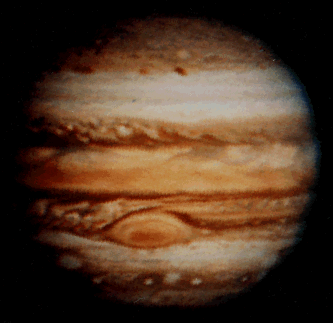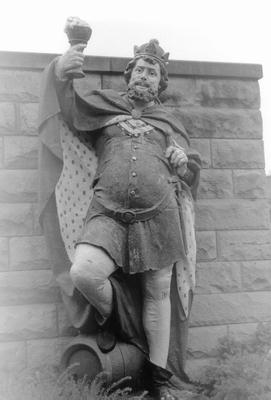So, you mentioned in a comment that you are thinking of getting a telescope as a Christmas gift. GREAT IDEA! Really. It will get the kids outside...at night...in December when it is freezing outside......and now that I put it that way I have to question your sanity.
But there is always the summer! And outdoors stuff is always fun. Telescopes are educational. There is a lot, and I do mean A LOT, of stuff to look at in the sky.
But first you need to know how to buy a telescope. The good ones are good - the cheap ones are garbage. You do not want to waste money on garbage. The garbage scopes will be hard to use, and will not work very well. Image quality will suck. It will be a big disappointment to everyone involved, and interest will quickly die.
So what do you look for? The most important thing is aperture. This is the size of the main lens or primary mirror. It is measured in either inches or millimeters. More is always better. Magnification is NOT AT ALL important! If the scope advertises magnification, it is probably junk. Sure, the 525x power looks impressive written on the box - but you are buying a telescope NOT a microscope. Even the best Earth based amateur scopes have trouble above 250 or 300x power - and these scopes can cost thousands. The reason is that the Earth is surrounded in air. This is good for us. The air distorts images, refracts light, contains pollution, and is different temperatures at different altitudes. Push your scope to 500x power and all you see is the turbulence in the atmosphere.
So you want to pay attention to the aperture. Magnification will take care of itself. For higher power you need larger aperture, or else all you get is a faint impossible to see image.
The second most important thing is the focal length. This is always measured in millimeters. Longer focal length scopes can get you higher power - but the images tend to be darker. As the focal length gets longer, you need more and more aperture.
Remember - a telescope is supposed to gather light (so you can see faint images) and not magnify stuff.
And here is how power, focal length, and aperture are all related. The power of a scope depends on the eyepiece. Eyepieces are measured in millimeters. A 20mm eyepiece has a larger opening than a 5mm eyepiece so more light can pass into the eye, resulting in a brighter image. And the 20mm eyepiece also gives a wider field of view. Power is calculated by taking the focal length and dividing it by the eyepiece focal length. So if you have a 2000mm focal length and a 20mm eyepiece, the magnification is 100x. Change to a 10mm eyepiece and you have 200x power. The telescope aperture has to be large enough to gather enough light to make the image bright enough for higher powers. I think that for scopes with apertures less than 6 inches, eyepieces under 10mm are not so great. The images are just too dim unless you are looking at the moon.
For viewing the moon, Jupiter and the 4 moons you can see with a backyard telescope, the rings of Saturn, Mars, and other bright objects a 60mm - 70mm (around 3 inches) scope is fine. For fainter images like nebulas and star clusters and such then you want to step up to 100mm - 120mm (4 - 4.5 inches). Above that and things get expensive fast.
Remember, larger apertures will allow you to "push" more magnification. And do not expect to see stuff like this.

This photo was taken by a space craft costing hundreds of millions of dollars. To your backyard scope, Jupiter will look much smaller. You can make out some bands and you will see the same moons Galileo saw. You can see that Saturn has rings - but you will not see NASA quality images.

This is another famous image. You are looking at the Cat's Eye Nebula. This photo was taken by the Hubble Space Telescope - a very large and very expensive telescope orbiting the planet. You can see the Cat's Eye with a backyard scope, but you will not see anything this detailed. Your eye is not as sensitive to light as film. Photographs are taken with long exposures so a lot of light is recorded. Your eye does not work this way. A lot of what you will see are faint blobs.
But there is still A LOT of stuff to see! So do not get discouraged. Just because you do not have something like the Hubble Telescope or the Galileo Space Probe does not mean you will not see anything.
Now you have the basics. Aperture is king, you know what focal length is, and you know what the numbers on the eyepiece means.
So where do you get a good scope from? I like these two places. I have bought stuff from each one. You can call their 800 number and people will be able to help you. They know the stuff they sell. Try that at a Wal-Mart!
Orion Telescopes and Binoculars and
www.telescopes.com. Orion's website is www.telescope.com but it is NOT the same company as telescopes.com!
And finally, there is one more thing to consider. Ease of use. Can you find stuff in the sky? Well can you? The moon and sun do not count. Do you know what is in the sky to look at tonight? Can you see Jupiter? Saturn? How about the "beehive" star cluster?
If you do not know, then you should consider a computerized scope. They are not as expensive as you think they may be. Once a computerized scope is lined up - it can find AND TRACK stuff for you. Tracking is important because everything is moving. Look at a planet under 150x power and you will see it zip through the field of view. You can see the Earth rotate! Cool huh?
So here are some of my picks for a good, quality, scope for kids who you think will really get into the astronomy thing!
This is a good 70mm scope that can be used day or night. You need to buy another thing for it for daytime use, or else the image will be upside down. You can use it to "sweep" the sky looking for things. It is not computerized. The lenses are glass - not plastic. It is a lot better than a cheapo department store scope. The tripod is stable enough. The whole thing is lightweight.
This 3 inch reflecting telescope works with two mirrors and requires periodic alignment. It has an EQ mount, which is harder to set up - but allows for easier tracking. EQ mounts move a scope in the same way the Earth rotates and are not good for daytime use at all. The mount can be motorized - but that is extra. You can also get the 70mm scope above on this mount.
To be honest, these two scopes are OK but not the best thing in the world. They are under $150 however - and for that price they are a good value. But for just a little bit more you can get so much more.
Like this
Meade ETX-80. This is an 80mm scope (aperture is getting larger!) that is super easy to set up, comes with a great tripod, and is computerized! Once you tell it where it is, what day it is, and where north is the scope does the rest. It picks two stars and points at them. You fine tune it by centering the star in the highest power eyepiece you have. After that it is set. Whatever is in the sky the scope can find. On its own. But this is not a "toy scope". It is a good quality instrument. At $300 still a good value for what you are getting, but perhaps a better idea as a second scope if the kids really like the first one.
But this - not this could be a winner! The
Meade NGC-70TC. This 70mm scope has enough aperture for a beginner to see a lot of stuff, and is not too large to be difficult to set up. It is computerized. You can use it in the daytime for looking at far away stuff or birds and wildlife. At $200 it is not insane expensive. It is a good scope. The lenses are good, the coatings are good, and it will be a lot nicer to use than a cheap toy scope at a department store.
There is also the
Meade NGC-60TC, which has 10mm less aperture than the 70TC - and has a manual goto computer. You pick the object from the controller, and the thing tells you which direction to move the scope to find the object. This scope is under $100 - because there are no motors to move the scope. Of course, this means there is no tracking. You will have to constantly adjust the telescope to keep objects in view. At higher powers, the objects will only remain in view for less than a minute. But the price is really good. To make the price lower, they have to cut corners. Like a more flimsy tripod. Or less quality optics.
You may also find other things on the telescopes.com website. Orion makes good stuff, Meade makes good stuff, and Celestron makes good stuff. Avoid Tasco. It is TRASHco.
I hope this is not all too much. If it is, there is still time to sort it out. Feel free to email any questions. Astronomy is a great hobby that really can last a lifetime. The night sky is vast, with thousands of objects visible from Earth. Once you get into astronomy, the night sky never looks the same again. You actually notice it. I find myself looking up all the time. I can pick out constellations. I can look at a bright "star" and know it is really Jupiter. I can even tell Saturn from Jupiter without a scope just by the color. Saturn is more "yellow" than Jupiter. I can pick out stars I know the name of.
Labels: telescopes





















